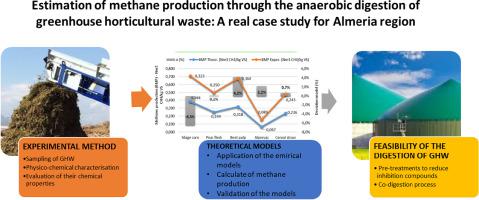Science of the Total Environment ( IF 9.8 ) Pub Date : 2021-10-16 , DOI: 10.1016/j.scitotenv.2021.151012 Luz M Gallego Fernández 1 , Esmeralda Portillo Estévez 1 , Benito Navarrete 1 , Rocío González Falcón 2

|
The methane production of greenhouse horticultural waste (GHW) from Almeria (Spain), from where fruits and vegetables are exported to all parts of Europe, was calculated in this work through a combination of experimental and theoretical methods. To this end, eight samples of GHW were collected and characterized in a waste treatment plant. The collection of samples was fairly distributed throughout the year to ensure a representative characterization. The amount of methane produced in a hypothetical anaerobic digestion process was predicted through empirical models fed by experimental data. The experimental characterization revealed that GHW contained an adequate content of volatile matter (65.72% TS), but a high value for total dry matter (53.46%) and lignin content (9.36%), as well as a low moisture content (46.54%) and C/N ratio (17.46). Inhibiting compounds were also observed in the characterization, such a S (0.43%) and Cl (1.41%). The methane production predicted was 0.229 Nm3 CH4/kg volatile matter, which may seem low in comparison to other waste potentially usable for anaerobic digestion. Nonetheless, the co-digestion of GHW with other waste could be an interesting alternative to enhance methane production and solve seasonality issues. Suitable pre-treatment can be also explored to increase the usability of GHW in anaerobic digestion. All in all, this work establishes a theoretical basis for potential solutions to manage the GHW produced in Almeria.
中文翻译:

通过厌氧消化温室园艺废物估算甲烷产量:阿尔梅里亚地区的真实案例研究
在这项工作中,通过结合实验和理论方法计算了来自阿尔梅里亚(西班牙)的温室园艺废物 (GHW) 的甲烷产量,从那里水果和蔬菜出口到欧洲各地。为此,在废物处理厂收集了 8 个 GHW 样品并对其进行了表征。样本收集在全年中公平分配,以确保具有代表性的特征。假设厌氧消化过程中产生的甲烷量是通过由实验数据提供的经验模型预测的。实验表征表明,GHW 含有足够含量的挥发物 (65.72% TS),但总干物质 (53.46%) 和木质素含量 (9.36%) 的值很高,以及水分含量 (46.54%) 低和 C/N 比 (17.46)。在表征中也观察到抑制性化合物,例如 S (0.43%) 和 Cl (1.41%)。预测的甲烷产量为 0.229 Nm3 CH 4 /kg 挥发性物质,与其他可用于厌氧消化的废物相比,这似乎很低。尽管如此,GHW 与其他废物的共同消化可能是提高甲烷产量和解决季节性问题的有趣替代方案。还可以探索合适的预处理,以提高 GHW 在厌氧消化中的可用性。总而言之,这项工作为管理阿尔梅里亚生产的 GHW 的潜在解决方案奠定了理论基础。

























 京公网安备 11010802027423号
京公网安备 11010802027423号